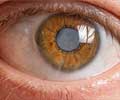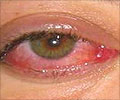- Gilbert Smolin, Charles Stephen Foster, et al., ‘Ectatic disorders of the cornea’, Smolin and Thoft's The cornea: scientific foundations and clinical practice, Pg-889.
About
Keratoconus is a progressive eye disease of the cornea. The normally prolate cornea gradually starts bulging at a point. Normally light passes through the cornea undistorted forming a clear image on the retina. In patients with Keratoconus, the light passing through the bulging cornea produces a distorted image.
These patients usually present to the doctor in their teens with gradually progressing diminution of vision. Their spectacle prescription changes frequently. When it progresses further, the patient is unable to see clearly even with glasses.

Keratoconus is a bilateral condition affecting both the eyes. Usually one eye is more severely affected than the other. Both males and females are equally affected. Keratoconus typically commences at puberty and progresses up to the third decade. After which progression of disease slows or stops.
The exact reason for the disease is not known. There are many theories like excessive eye rubbing and genetic predisposition to deficient collagen cross linking making the cornea weak. There is no scientific evidence to support this.

Diagnosis is made by an ophthalmologist by examination with a slit lamp, video keratography, or a topography. There are many treatment modalities now available to improve vision in these cases as well as to halt the progression. Rigid gas permeable contact lenses are special lenses, which help improve vision in patients of Keratoconus. The newer modalities of improving vision are the intacs and phakic IOL. Procedures like C3R are done to strengthen the cornea and halt the progression of disease.






